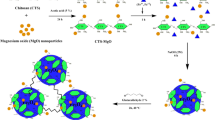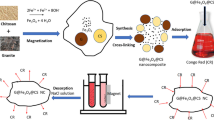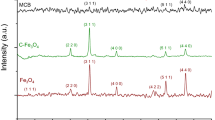Abstract
The efficient removal of harmful dyes from wastewater, employing green methods, is a subject of growing interest. Anthraquinone dyes alizarin red (AR) S and methyl orange (MO) were used as model pollutants in this investigation, and magnetic chitosan particles were used to extract them from aqueous solution. SEM–EDX, XRD, FTIR ATR, and TGA DSC were used to examine the physicochemical, thermal, and morphological properties of the synthesized material. The effect of pH, dye concentration, duration, and adsorbent loading on dye degradation was examined. After adsorption, the material could be easily separated with the assistance of an external magnet. The selective adsorption of alizarin red S dye to methyl orange was studied in single and binary solutions. The dye uptake capacity provided by the use of the pseudo-second-order model is higher as compared to the pseudo-first order. The dye was adsorbed at 201.5 mg/g for 120 min. The batch adsorption followed the Freundlich isotherm (R2 = 0.995) with alizarin red adsorption being endothermic with the presence of multimolecular layer adsorption. Desorption efficiency decreases to 90% after the first cycle. For repeated usage, the material proved to be extremely stable and easy to recycle. The adsorption mechanism of AR and MO dye removal by magnetic chitosan adsorbent is proposed.
Graphical abstract













Similar content being viewed by others
Availability of data and material
All data generated or analyzed during this study are included in this published article.
Code availability
Not applicable.
References
Ali N, Ali F, Ullah I, Ali Z, Duclaux L, Reinert L, Leveque JM, Farooq A, Bilal M, Ahmad I (2020a) Organically modified micron-sized vermiculite and silica for efficient removal of Alizarin Red S dye pollutant from aqueous solution. Environ Technol Innov 19:101001. https://doi.org/10.1016/j.eti.2020.101001
Ali N, Uddin S, Khan A, Khan S, Khan S, Ali N, Khan H, Khan H, Bilal M (2020b) Regenerable chitosan-bismuth cobalt selenide hybrid microspheres for mitigation of organic pollutants in an aqueous environment. Int J Biol Macromol 161:1305–1317. https://doi.org/10.1016/j.ijbiomac.2020.07.132
Anush SM, Chandan HR, Gayathri BH, Asma MN, Vishalakshi B, Kalluraya B (2020) Graphene oxide functionalized chitosan-magnetite nanocomposite for removal of Cu(II) and Cr(VI) from waste water. Int J Biol Macromol 164:4391–4402. https://doi.org/10.1016/j.ijbiomac.2020.09.059
Aziz A, Ali N, Khan A, Bilal M, Malik S, Ali N, Khan H (2020) Chitosan-zinc sulfide nanoparticles, characterization and their photocatalytic degradation efficiency for azo dyes. Int J Biol Macromol 153:502–512. https://doi.org/10.1016/j.ijbiomac.2020.02.310
Bagheri H, Roostaie A, Baktash MY (2014) A chitosan-polypyrrole magnetic nanocomposite as μ-sorbent for isolation of naproxen. Anal Chim Acta 816:1–7. https://doi.org/10.1016/j.aca.2014.01.028
Batool SS, Imran Z, Hassan S, Rasool K, Ahmad M, Rafiq MA (2016) Enhanced adsorptive removal of toxic dyes using SiO2 nanofibers. Solid State Sci 55:13–20. https://doi.org/10.1016/j.solidstatesciences.2016.02.001
Bayat A, Tati A, Ahmadipouya S, Haddadi SA, Arjmand M (2021) Electrospun chitosan/polyvinyl alcohol nanocomposite holding polyaniline/silica hybrid nanostructures: An efficient adsorbent of dye from aqueous solutions. J Mol Liq 331:115734. https://doi.org/10.1016/j.molliq.2021.115734
Begum S, Ahmaruzzaman M (2018) Green Synthesis of SnO2 Nanoparticles loaded on Activated Carbon and its Application as Photocalayst in the Degradation of Alizarin Red S Dye. Mater Today Proc 5:2314–2320. https://doi.org/10.1016/j.matpr.2017.09.235
Bouarioua A, Zerdaoui M (2017) Photocatalytic activities of TiO2 layers immobilized on glass substrates by dip-coating technique toward the decolorization of methyl orange as a model organic pollutant. J Environ Chem Eng 5:1565–1574. https://doi.org/10.1016/j.jece.2017.02.025
Budi CS, Deka JR, Hsu WC, Saikia D, Chen KT, Kao HM, Yang YC (2021) Bimetallic Co/Zn zeolitic imidazolate framework ZIF-67 supported Cu nanoparticles: An excellent catalyst for reduction of synthetic dyes and nitroarenes. J Hazard Mater 407:124392. https://doi.org/10.1016/j.jhazmat.2020.124392
Burakov A, Neskoromnaya E, Babkin A (2019) Removal of the Alizarin Red S Anionic Dye Using Graphene Nanocomposites: A study on Kinetics under Dynamic Conditions. Mater Today Proc 11:392–397. https://doi.org/10.1016/j.matpr.2019.01.002
Cai J, Pan A, Li Y, Xiao Y, Zhou Y, Chen C, Sun F, Su X (2021) A novel strategy for enhancing anaerobic biodegradation of an anthraquinone dye reactive blue 19 with resuscitation-promoting factors. Chemosphere 263:127922. https://doi.org/10.1016/j.chemosphere.2020.127922
Chaudhary M, Maiti A (2020) Fe–Al–Mn@chitosan based metal oxides blended cellulose acetate mixed matrix membrane for fluoride decontamination from water: Removal mechanisms and antibacterial behavior. J Memb Sci 611:118372. https://doi.org/10.1016/j.memsci.2020.118372
Chaudhary M, Jain N, Maiti A (2021) A comparative adsorption kinetic modeling of fluoride adsorption by nanoparticles and its polymeric nanocomposite. J Environ Chem Eng 9:105595. https://doi.org/10.1016/j.jece.2021.105595
Chen W, Li W, Liu F, Miao D, Ma L, Gao X, Wei Q, Zhou K, Yu Z, Yu Y (2020) Microstructure of boron doped diamond electrodes and studies on its basic electrochemical characteristics and applicability of dye degradation. J Environ Chem Eng. https://doi.org/10.1016/j.jece.2020.104348
da Silva RJ, Mojica-Sánchez LC, Gorza FDS, Pedro GC, Maciel BG, Ratkovski GP, da Rocha HD, do Nascimento KTO, Medina-Llamas JC, Chavez-Guajardo AE, Alcaraz-Espinoza JJ, de Melo CP, (2021) Kinetics and thermodynamic studies of Methyl Orange removal by polyvinylidene fluoride-PEDOT mats. J Environ Sci (china) 100:62–73. https://doi.org/10.1016/j.jes.2020.04.034
Dai K, Zhao G, Kou J, Wang Z, Zhang J, Wu J, Yang P, Li M, Tang C, Zhuang W, Ying H (2021) Magnetic mesoporous sodium citrate modified lignin for improved adsorption of calcium ions and methylene blue from aqueous solution. J Environ Chem Eng 9:105180. https://doi.org/10.1016/j.jece.2021.105180
Dayanidhi K, Vadivel P, Jothi S, Eusuff NS (2020) Facile synthesis of Silver@Eggshell nanocomposite: A heterogeneous catalyst for the removal of heavy metal ions, toxic dyes and microbial contaminants from water. J Environ Manage 271:110962. https://doi.org/10.1016/j.jenvman.2020.110962
Demissie H, An G, Jiao R, Ritigala T, Lu S, Wang D (2021) Modification of high content nanocluster-based coagulation for rapid removal of dye from water and the mechanism. Sep Purif Technol 259:117845. https://doi.org/10.1016/j.seppur.2020.117845
Devi LG, Munikrishnappa C, Nagaraj B, Rajashekhar KE (2013) Effect of chloride and sulfate ions on the advanced photo Fenton and modified photo Fenton degradation process of Alizarin Red S. J Mol Catal A Chem 374–375:125–131. https://doi.org/10.1016/j.molcata.2013.03.023
Gautam RK, Mudhoo A, Chattopadhyaya MC (2013) Kinetic, equilibrium, thermodynamic studies and spectroscopic analysis of Alizarin Red S removal by mustard husk. J Environ Chem Eng 1:1283–1291. https://doi.org/10.1016/j.jece.2013.09.021
Germani R, Bini M, Fantacci S, Simonetti F, Tiecco M, Vaioli E, Giacco TD (2021) Influence of surfactants in improving degradation of polluting dyes photocatalyzed by TiO2 in aqueous dispersion. J Photochem Photobiol A Chem 418:113342. https://doi.org/10.1016/j.jphotochem.2021.113342
Gholivand MB, Yamini Y, Dayeni M, Seidi S, Tahmasebi E (2015) Adsorptive removal of alizarin red-S and alizarin yellow GG from aqueous solutions using polypyrrole-coated magnetic nanoparticles. J Environ Chem Eng 3:529–540. https://doi.org/10.1016/j.jece.2015.01.011
Gollakota ARK, Munagapati VS, Volli V, Gautam S, Wen JC, Shu CM (2021) Coal bottom ash derived zeolite (SSZ-13) for the sorption of synthetic anion Alizarin Red S (ARS) dye. J Hazard Mater 416:125925. https://doi.org/10.1016/j.jhazmat.2021.125925
Huo MX, Jin YL, Sun ZF, Ren F, Pei L, Ren PG (2021) Facile synthesis of chitosan-based acid-resistant composite films for efficient selective adsorption properties towards anionic dyes. Carbohydr Polym 254:117473. https://doi.org/10.1016/j.carbpol.2020.117473
Joshi M, Kamble SP, Labhsetwar NK, Parwate DV, Rayalu SS (2009) Chlorophyll-based photocatalysts and their evaluations for methyl orange photoreduction. J Photochem Photobiol A Chem 204:83–89. https://doi.org/10.1016/j.jphotochem.2009.01.016
Kadir HA, Abu Bakar NHH, Sabri NA, Abdullah FH, Abu Bakar M, Furuno H, Saito N (2020) Silver nanoparticles incorporated in dicarboxylic/TEPA modified halloysite nanotubes for the degradation of organic contaminants. Appl Surf Sci 531:147417. https://doi.org/10.1016/j.apsusc.2020.147417
Kamarehie B, Jafari A, Ghaderpoori M, Karami MA, Mousavi K, Ghaderpoury A (2018) Data on the alizarin red S adsorption from aqueous solutions on PAC, treated PAC, and PAC/γ≈Fe2O3. Data Br 20:903–908. https://doi.org/10.1016/j.dib.2018.08.170
Kumar RS (2018) Indian textile industry: opportunities, challenges and suggestions. Trends Text Eng Fash Technol 2:189–193. https://doi.org/10.31031/tteft.2018.02.000538
Latifi Pour M, Kazemeini M, Sadjadi S (2021) Nanocomposite of functionalized halloysite and Ag(0) decorated magnetic carbon dots as a reusable catalyst for reduction of dyes in water. J Phys Chem Solids. https://doi.org/10.1016/j.jpcs.2021.109949
Li Y, Wang T, Zhang S, Zhang Y, Yu L, Liu R (2021) Adsorption and electrochemical behavior investigation of methyl blue onto magnetic nickel-magnesium ferrites prepared via the rapid combustion process. J Alloys Compd 885:160969. https://doi.org/10.1016/j.jallcom.2021.160969
Liang YD, He YJ, Zhang YH, Zhu QQ (2018) Adsorption property of alizarin red S by NiFe2O4/polyaniline magnetic composite. J Environ Chem Eng 6:416–425. https://doi.org/10.1016/j.jece.2017.12.022
Liao QG, Hu LF, Luo LG (2015) A chitosan-polypyrrole@Fe3O4 nanocomposite for magnetic solid-phase extraction of macrolides from swine urine samples. Anal Methods 7:2806–2812. https://doi.org/10.1039/c4ay02907k
Liu M, Zhang X, Li Z, Qu L, Han R (2020) Fabrication of zirconium (IV)-loaded chitosan/Fe3O4/graphene oxide for efficient removal of alizarin red from aqueous solution. Carbohydr Polym 248:116792. https://doi.org/10.1016/j.carbpol.2020.116792
Liu M, Yin W, Zhao TL, Yao QZ, Fu SQ, Zhou GT (2021) High-efficient removal of organic dyes from model wastewater using Mg(OH)2-MnO2 nanocomposite: Synergistic effects of adsorption, precipitation, and photodegradation. Sep Purif Technol 272:118901. https://doi.org/10.1016/j.seppur.2021.118901
Mahouche-Chergui S, Boussaboun Z, Oun A, Kazembeyki M, Hoover CG, Carbonnier B, Ouellet-Plamondon CM (2021) Sustainable preparation of graphene-like hybrid nanomaterials and their application for organic dyes removal. Chem Eng Sci 236:116482. https://doi.org/10.1016/j.ces.2021.116482
Mashkoor F, Nasar A (2020) Facile synthesis of polypyrrole decorated chitosan-based magsorbent: Characterizations, performance, and applications in removing cationic and anionic dyes from aqueous medium. Int J Biol Macromol 161:88–100. https://doi.org/10.1016/j.ijbiomac.2020.06.015
Mian MM, Liu G (2020) Activation of peroxymonosulfate by chemically modified sludge biochar for the removal of organic pollutants: understanding the role of active sites and mechanism. Chem Eng J 392:123681. https://doi.org/10.1016/j.cej.2019.123681
Mota HP, Quadrado RFN, Burgo TAL, Iglesias BA, Fajardo AR (2020) Polysaccharide/Fe(III)-porphyrin hybrid film as catalyst for oxidative decolorization of toxic azo dyes: an approach for wastewater treatment. Arab J Chem 13:5923–5938. https://doi.org/10.1016/j.arabjc.2020.04.021
Nawaz A, Khan A, Ali N, Ali N, Bilal M (2020) Fabrication and characterization of new ternary ferrites-chitosan nanocomposite for solar-light driven photocatalytic degradation of a model textile dye. Environ Technol Innov 20:101079. https://doi.org/10.1016/j.eti.2020.101079
Neelgund GM, Oki A (2021) Folic acid and CuS conjugated graphene oxide: An efficient photocatalyst for explicit degradation of toxic dyes. Appl Surf Sci 566:150648. https://doi.org/10.1016/j.apsusc.2021.150648
Nguyen TD, Dang CH, Mai DT (2018) Biosynthesized AgNP capped on novel nanocomposite 2-hydroxypropyl-β-cyclodextrin/alginate as a catalyst for degradation of pollutants. Carbohydr Polym 197:29–37. https://doi.org/10.1016/j.carbpol.2018.05.077
Palza H, Delgado K, Govan J (2019) Novel magnetic CoFe2O4/layered double hydroxide nanocomposites for recoverable anionic adsorbents for water treatment. Appl Clay Sci 183:105350. https://doi.org/10.1016/j.clay.2019.105350
Pourebrahim F, Ghaedi M, Dashtian K, Heidari F, Kheirandish S (2017) Simultaneous removing of Pb2+ ions and alizarin red S dye after their complexation by ultrasonic waves coupled adsorption process: spectrophotometry detection and optimization study. Ultrason Sonochem 35:51–60. https://doi.org/10.1016/j.ultsonch.2016.09.002
Qamar SA, Ashiq M, Jahangeer M, Riasat A, Bilal M (2020) Chitosan-based hybrid materials as adsorbents for textile dyes–A review. Case Stud Chem Environ Eng 2:100021. https://doi.org/10.1016/j.cscee.2020.100021
Rahimi Z, Zinatizadeh AA, Zinadini S, Van Loosdrecht M (2021) A hydrophilic and antifouling nanofiltration membrane modified by citric acid functionalized tannic acid (CA-f-TA) nanocomposite for dye removal from biologically treated baker’s yeast wastewater. J Environ Chem Eng 9:104963. https://doi.org/10.1016/j.jece.2020.104963
Ramavandi B, Najafpoor AA, Alidadi H, Bonyadi Z (2019) Alizarin red-S removal from aqueous solutions using saccharomyces cerevisiae: kinetic and equilibrium study. Desalin Water Treat 144:286–291. https://doi.org/10.5004/dwt.2019.23556
Rani M, Shanker U, Chaurasia AK (2017) Catalytic potential of laccase immobilized on transition metal oxides nanomaterials: Degradation of alizarin red S dye. J Environ Chem Eng 5:2730–2739. https://doi.org/10.1016/j.jece.2017.05.026
Rehman R, Waheed-Uz-Zaman RA, Noor W, Batool A, Maryem H (2021) Photocatalytic degradation of alizarin red S, Amaranth, congo red, and rhodamine B dyes using UV light modified reactor and ZnO, TiO2, and SnO2 as catalyst. J Chem. https://doi.org/10.1155/2021/6655070
Riaz U, Ashraf SM, Budhiraja V, Aleem S, Kashyap J (2016) Comparative studies of the photocatalytic and microwave -assisted degradation of alizarin red using ZnO/poly(1- naphthylamine) nanohybrids. J Mol Liq 216:259–267. https://doi.org/10.1016/j.molliq.2016.01.018
Sargin I, Baran T, Arslan G (2020) Environmental remediation by chitosan-carbon nanotube supported palladium nanoparticles: Conversion of toxic nitroarenes into aromatic amines, degradation of dye pollutants and green synthesis of biaryls. Sep Purif Technol 247:116987. https://doi.org/10.1016/j.seppur.2020.116987
Sayğılı H (2019) Hydrothermal synthesis of magnetic nanocomposite from biowaste matrix by a green and one-step route: Characterization and pollutant removal ability. Bioresour Technol 278:242–247. https://doi.org/10.1016/j.biortech.2019.01.103
Sirajudheen P, Poovathumkuzhi NC, Vigneshwaran S, Chelaveettil BM, Meenakshi S (2021) Applications of chitin and chitosan based biomaterials for the adsorptive removal of textile dyes from water — A comprehensive review. Carbohydr Polym 273:118604. https://doi.org/10.1016/j.carbpol.2021.118604
Sun Y, Li D, Lu X, Sheng J, Zheng X, Xiao X (2021) Flocculation of combined contaminants of dye and heavy metal by nano-chitosan flocculants. J Environ Manage. https://doi.org/10.1016/j.jenvman.2021.113589
Thasneema KK, Dipin T, Thayyil MS, Sahu PK, Messali M, Rosalin T, Elyas KK, Saharuba PM, Anjitha T, Hadda TB (2021) Removal of toxic heavy metals, phenolic compounds and textile dyes from industrial waste water using phosphonium based ionic liquids. J Mol Liq 323:114645. https://doi.org/10.1016/j.molliq.2020.114645
Unsoy G, Yalcin S, Khodadust R, Gunduz G, Gunduz U (2012) Synthesis optimization and characterization of chitosancoated iron oxide nanoparticles produced for biomedical applications. J Nanoparticle Res. https://doi.org/10.1007/s11051-012-0964-8
Usman M, Ahmed A, Yu B, Wang S, Shen Y, Cong H (2021) Simultaneous adsorption of heavy metals and organic dyes by β-Cyclodextrin-Chitosan based cross-linked adsorbent. Carbohydr Polym 255:117486. https://doi.org/10.1016/j.carbpol.2020.117486
Vedula SS, Yadav GD (2021a) Chitosan-based membranes preparation and applications: challenges and opportunities. J Indian Chem Soc. https://doi.org/10.1016/j.jics.2021.100017
Vedula SS, Yadav GD (2021b) Wastewater treatment containing methylene blue dye as pollutant using adsorption by chitosan lignin membrane: Development of membrane, characterization and kinetics of adsorption. J Indian Chem Soc. https://doi.org/10.1016/j.jics.2021.100263
Vigneshwaran S, Sirajudheen P, Nabeena CP, Meenakshi S (2021) In situ fabrication of ternary TiO2 doped grafted chitosan/hydroxyapatite nanocomposite with improved catalytic performance for the removal of organic dyes: Experimental and systemic studies. Colloids Surfaces A Physicochem Eng Asp 611:125789. https://doi.org/10.1016/j.colsurfa.2020.125789
Wang Z, Li Y, Xie X, Wang Z (2021) Bifunctional MnFe2O4/chitosan modified biochar composite for enhanced methyl orange removal based on adsorption and photo-Fenton process. Colloids Surfaces A Physicochem Eng Asp 613:126104. https://doi.org/10.1016/j.colsurfa.2020.126104
Yang JY, Jiang XY, Jiao FP, Yu JG (2018) The oxygen-rich pentaerythritol modified multi-walled carbon nanotube as an efficient adsorbent for aqueous removal of alizarin yellow R and alizarin red S. Appl Surf Sci 436:198–206. https://doi.org/10.1016/j.apsusc.2017.12.029
Zayed MF, Eisa WH, Hosam AEHM, Abou Zeid AM (2020) Spectroscopic investigation of chitosan-supported Cu2O/CuO nanocomposite; a separable catalyst for water-pollutants degradation. J Alloys Compd 835:155306. https://doi.org/10.1016/j.jallcom.2020.155306
Zhang Z, Zhu L, Lu W, Li X, Sun X, Lu R, Ding H (2016) Evaluation of functional group content of N-methylimidazolium anion exchange resin on the adsorption of methyl orange and alizarin red. Chem Eng Res Des 111:161–168. https://doi.org/10.1016/j.cherd.2016.05.008
Zhang Z, Chen H, Wu W, Pang W, Yan G (2019) Efficient removal of Alizarin Red S from aqueous solution by polyethyleneimine functionalized magnetic carbon nanotubes. Bioresour Technol 293:122100. https://doi.org/10.1016/j.biortech.2019.122100
Zhao X, Shi Y, Cai Y, Mou S (2008) Cetyltrimethylammonium bromide-coated magnetic nanoparticles for the preconcentration of phenolic compounds from environmental water samples. Environ Sci Technol 42:1201–1206. https://doi.org/10.1021/es071817w
Zhou J, Zhang C, Niu T, Huang R, Li S, Sun J, Wang Y (2019) Facile synthesis of reusable magnetic Fe/Fe3C/C composites from renewable resources for super-fast removal of organic dyes: characterization, mechanism and kinetics. Powder Technol 351:314–324. https://doi.org/10.1016/j.powtec.2019.04.016
Acknowledgements
SSV acknowledges the University Grants Commission (UGC) for awarding the Senior Research Fellowship under its Green Technology special meritorious fellowship program. GDY acknowledges the financial support as R. T. Mody Distinguished Professor, Tata Chemicals Darbari Seth Distinguished Professor of Leadership and Innovation, J.C.Bose National Fellow, and National Science Chair (Mode I) of Science and Engineering Research Board, GOI.
Author information
Authors and Affiliations
Contributions
CRediT taxonomy: SV contributed to formal analysis-lead, investigation-lead, methodology-lead, writing–original draft-lead. GDY contributed to conceptualization-equal, funding acquisition-equal, project administration-equal, resources-lead, supervision-equal, writing–review and editing-equal.
Corresponding author
Ethics declarations
Conflict of interest
The authors have declared no conflict of interest.
Additional information
Publisher's Note
Springer Nature remains neutral with regard to jurisdictional claims in published maps and institutional affiliations.
Supplementary Information
Below is the link to the electronic supplementary material.
Rights and permissions
Springer Nature or its licensor holds exclusive rights to this article under a publishing agreement with the author(s) or other rightsholder(s); author self-archiving of the accepted manuscript version of this article is solely governed by the terms of such publishing agreement and applicable law.
About this article
Cite this article
Vedula, S.S., Yadav, G.D. Treatment of wastewater containing alizarin red dye: development and application of magnetic chitosan as a natural eco-friendly material. Clean Techn Environ Policy 25, 865–878 (2023). https://doi.org/10.1007/s10098-022-02408-9
Received:
Accepted:
Published:
Issue Date:
DOI: https://doi.org/10.1007/s10098-022-02408-9




